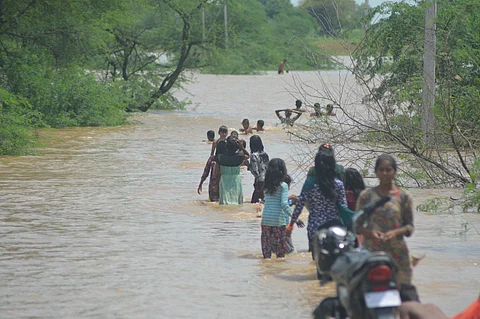Decades of drought end in deluge: Bundelkhand sees 200% surge in rainfall, kharif crops ruined
Tikamgarh and Niwari in MP recorded 212% and 315% more rainfall respectively
All 14 dams in Lalitpur are full to capacity, water being released
Kharif crops like peanut, sesame, green gram (moong) and black gram (urad) crops destroyed
Continuous rains have triggered flooding, collapsed homes and inaccessible roads
Experts link the unseasonal rain pattern to climate change
After nearly two decades of chronic water scarcity, Bundelkhand — a drought-prone region spanning parts of Uttar Pradesh and Madhya Pradesh — has witnessed an extraordinary spell of monsoon rainfall that has left fields flooded and crops ruined. According to the India Meteorological Department (IMD), the rainfall in many districts has been up to three times the normal average, making it impossible for farmers to sow or salvage their Kharif crops.
In Madhya Pradesh’s Tikamgarh and Niwari districts, more than 90 per cent of agricultural fields have not been sown this season. Social worker Rohit, a local resident, said in the 10 per cent of fields where sowing was attempted, seed germination failed due to waterlogging.
“The rains have brought destruction, not relief,” he told Down to Earth, citing hundreds of millimetres of rainfall between July 11 and 14, which particularly damaged peanut and black gram crops.
Rainfall up to 315 per cent above normal
The IMD data highlights how extraordinary the rainfall has been:
Tikamgarh has received 835 mm of rainfall by 16 July, against a normal of 268 mm — 212 per cent above average.
Niwari has recorded 805 mm, compared to a normal of 194 mm—a 315 per cent increase, the highest in the state.
The region has already received 98 per cent of its annual rainfall in just two months.
Neighbouring districts have also seen extreme rainfall:
Chhatarpur: +190 per cent
Panna: +102 per cent
Damoh: +77 per cent
Sagar: +69 per cent
Datia: +37 per cent (classified as ‘excess’; others as ‘large excess’)
Vasudev, secretary of the Lalitpur-based NGO Bundelkhand Seva Sansthan, said all 14 major dams in the district are now full and water is being released to manage reservoir pressure.
Homes collapse, fields flood
The impact extends beyond agriculture. Villagers like Sameena Yusuf from Panna report collapsed homes, blocked roads and a flood-like situation due to continuous rain since June 23. She warned that this rainfall is not just unusual but "disruptive to life and livelihood."
Many mud houses have caved in and residents are unable to work or access essential services. “It’s been 20 years since we’ve seen anything like this,” she added, noting that most of the sesame, black gram (urad), green gram (moong) and peanut seeds have been washed away.
Uttar Pradesh districts also hit hard
The Uttar Pradesh side of Bundelkhand is experiencing a similar fate. Veteran journalist Ashok Nigam in Banda recalls only two comparable monsoons — in 1992 and 1982. He said, “This rain has destroyed Kharif crops entirely. Fields are submerged and fertile topsoil has been eroded.”
In Banda’s Bashari village, sesame is the primary Kharif crop. Resident Ghanshyam Kumar lamented that no sowing was possible this year. “The village pond is full for the first time in decades, but it comes at the cost of an entire season's livelihood,” he said.
District-level rainfall increases are stark:
Lalitpur: +185 per cent
Mahoba: +139 per cent
Hamirpur: +123 per cent
Banda: +86 per cent
Chitrakoot: +70 per cent
Jalaun: +65 per cent
Jhansi: +58 per cent
Except for Jhansi (excess), all are in the ‘large excess’ rainfall category.
Dams swell, rivers rise
Across the region, rivers such as the Ken, Betwa and Yamuna are swollen and flowing above danger levels. Bridges and embankments have been reported washed away in several areas.
Mahoba resident and farmer Rajkumar Chaurasia, aged 56, said he had never seen such rainfall in his lifetime. The Urmil Dam — shared by Mahoba and Chhatarpur — was nearing capacity and the major ponds of Mahoba (Kirat Sagar, Madan Sagar, Vijay Sagar) are likely to be full within days.
Climate change a likely culprit
Experts suggest that the timing and intensity of rainfall have shifted dramatically this year, with heavy monsoons arriving weeks earlier than usual. The pattern deviates sharply from Bundelkhand’s historical norm of receiving rain after mid-July. This shift, many believe, is linked to climate change and highlights the growing unpredictability of India's monsoon system.
As farmers across the region face a lost Kharif season, the unseasonal bounty of water raises new questions about resilience, climate adaptation and future agricultural planning in one of India's most vulnerable regions.


